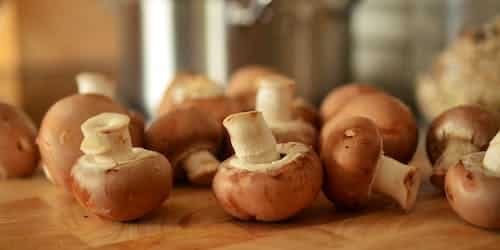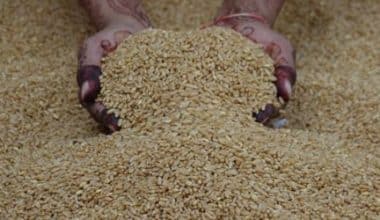Mushroom farming in Nigeria may appear to be a difficult and time-consuming endeavour, but if you look closer, there is something rather appealing about it. According to National Farmers Information Service (NAFIS) figures, Nigeria produces 300 metric tons of mushrooms each year, compared to a requirement of 1200 metric tons.
As a result, buyers such as residences and hotels must import from elsewhere because local farmers are unable to meet demand, and this presents a rich business opportunity for you to invest in. This essay has covered all you need to know about running a profitable mushroom business in Nigeria.
Have you heard of mushroom pinning? Read it here.
What is Mushroom?
Mushrooms are edible fungi with a squishy texture and a distinctive umami flavour. They are categorized as fungi and are generally grouped into several genera, such as Agaricus, Pleurotus, and Lentinula, among others. Mushroom farming is the cultivation of fungi for human consumption or medical use.
What is Mushroom Farming in Nigeria About?
Mushroom farming, often known as mushroom culture, is the technique of commercially raising edible mushrooms. It entails growing mushrooms in a suitable substrate under appropriate environmental conditions. In Nigeria and Africa, mushroom farming often entails cultivating various edible mushrooms such as oysters, shiitake, and button mushrooms. Because they contain vital amino acids, vitamins, and minerals, these mushrooms are a popular addition to many recipes.
Mushroom farming is becoming more popular in Nigeria and Africa due to its high-profit potential and minimal input needs, making it an appealing option for small-scale farmers.
Is Mushroom Farming a Profitable Business?
Mushroom farming in Nigeria is scarce, despite strong demand. Starting a mushroom farm will put you in a market where the product is in high demand but there are few supply. As a result, you don’t have to be concerned about not obtaining customers.
Furthermore, mushroom cultivation requires some effort (what company does not? ), but the reward outweighs the effort. This business can make you a fortune if you understand how to execute it properly.
How Much Money Can You Make From Mushroom Farming?
Millions are made by mushroom farmers! Of course, the amount you profit at the conclusion of a season is a function of the amount you invest in mushroom seeds.
For example, you made 25 bags of oysters weighing around 500 kg. 1 kilogram of oysters costs N2000; 500 kilograms of oysters cost N2000 500 = 1,000,000 naira.
The Advantages of Mushroom Farming in Nigeria
The following are the ten advantages of mushroom cultivation in Nigeria and Africa:
- High demand: Mushrooms are in high demand in Nigeria and Africa, making it a successful investment for farmers.
- Nutritional benefits: Mushrooms are high in nutrients and include critical vitamins, minerals, and antioxidants that promote optimum health.
- Easy to grow: Mushroom farming takes up less space and may be farmed all year, making it a viable alternative for small-scale growers.
- Substantial yield: Because mushrooms grow quickly and can be harvested numerous times each year, mushroom farming can produce substantial returns.
- Environmentally friendly: Mushroom farming is an environmentally friendly agricultural activity since it uses organic materials and generates less trash than regular farming.
- Additional revenue: Mushroom growing can supplement farmers’ income, particularly during the off-season when other crops are not in season.
- Job creation: Mushroom cultivation generates employment opportunities throughout the value chain’s processing, packaging, and marketing stages.
- Health benefits: Mushroom consumption has been associated to a lower risk of chronic diseases such as cancer, heart disease, and diabetes.
- Easy to transport: Mushrooms are simple to transport and can be marketed in both local and international markets.
- Cost-effective: Mushroom growing involves few inputs and can be started with little money, making it a cost-effective endeavor for farmers.
Types Of Mushrooms Used For Mushroom Farming in Nigeria
In Nigeria and Africa, various varieties of mushrooms are utilized for mushroom growing, including:
- Oyster mushroom (Pleurotus spp.): This variety of mushroom is simple to grow and high in nutritional content.
- Button mushroom (Agaricus bisporus): This is the most widely grown mushroom in the world, and it has a moderate flavor.
- Shiitake mushrooms (Lentinula edodes): These mushrooms are highly prized for their therapeutic characteristics and are often used in Asian cuisine.
- Reishi mushroom (Ganoderma lucidum): This mushroom is well-known for its therapeutic characteristics and is widely utilized in traditional Chinese medicine.
- Enoki mushroom (Flammulina velutipes): This fungus is distinguished by its long, thin stems and delicate flavor.
- Hericium erinaceus (Lion’s mane mushroom): This type of fungus is highly appreciated for its therapeutic characteristics and is often employed in traditional Chinese medicine.
- Wood ear mushroom (Auricularia auricula-judae): This fungus is popular in Asian cuisine due to its crispy texture.
These are only a handful of the mushrooms used in mushroom growing in Nigeria and Africa. Climate, market demand, and the grower’s preference and expertise will all influence the type of mushroom grown.
Step-By-Step Instructions for Starting Mushroom Farming in Nigeria
Starting a mushroom farm in Nigeria or elsewhere in Africa might be a lucrative economic enterprise. Here’s a step-by-step guide to getting started:
Step #1: Get Started
Of course, you’ll need some space to grow your mushrooms. A 1/8th-acre plot of land would be sufficient to establish a huge farm capable of producing up to 2 tons of mushrooms every 2 months (using the shelf-frame method).
Step #2: Build a Simple House
Once you’ve found a suitable plot of land, you’ll need to construct a small mud house and a few wooden shelves to take advantage of the available vertical space. Your local carpenter can assist you with this, and you can save money by improvising using locally available materials. (Note: Make sure the house is sufficiently aerated to facilitate proper air circulation.)
Step #3: Locate the substrate
The substrate is the first and most critical supply you will require. The substrate is the material on which mushrooms grow. This can include farm or timber waste such as sawdust, rice bran, wheat bran, lime, and so on. Make certain that this is sterilized, as even a minor bacterial infection might devastate your entire farm. A bag of sawdust costs N50, and you will require approximately 50 bags.
Step #4: Purchase Nylon Bags
Small bags will be needed to prepare the seedlings, as well as large bags for the final planting. Small bags, like those used by shops to package 2 kg of sugar, typically cost N100 for 200 pieces. Larger bags can cost as much as N30 per piece, and an agricultural plot will require approximately 1000 of them.
Step #5: Invest In Good Hygiene
Good cleanliness is essential on a mushroom farm, as you will learn from farm training courses. As a result, you’ll need to purchase items such as hand gloves, methylated alcohol, and cotton wool. A box of gloves costs N1,500, as does methylated alcohol and cotton wool. Drinking straws (N1,000) and a knapsack sprayer (N6,500) are two other items that may be required.
Step #6: Collect the Seeds
Finally, some mushroom seedlings (also known as spawns) are required. Button spawns are the most popular (and easiest to promote) spawns. These are available from DILOMAT or FIIRO. Oyster spawn costs N2,000 per kilogram. 5 kg should suffice to get you started. Other types of mushrooms you can grow are shiitake and button.
5 Stages of Mushroom Cultivation
While mushroom gardening generally follows these five stages, not all of them necessitate careful management for the greatest results. Because not all mushrooms will adhere to all five of the aforementioned processes. It is different for each species. Furthermore, some species may require specific conditions for growth and development.
#1. Preparation
Surprisingly, before you can begin mushroom gardening, you must first prepare the bed with several substrates. In Nigeria, many substrates are appropriate for mushroom farming. Here are several examples:
- Banana leaves
- Banana stems
- Oil palm fruit fiber
- Oil palm bunch
- Banana peels
- Corn husk
#2. Spawning
Spawning is just the planting of mushroom seeds. The mushrooms will enter a vegetative condition as a result of this treatment. After they are spawned, the mycelium will expand and run through the system in a few days, as seen by the white hue. You don’t keep it like this since you don’t want the fruiting bodies to appear.
This brings us to the next stage, known as casing.
#3. Casing
The important ingredient in this case is calcium carbonate soil, which is necessary to cover the mushroom in its white vegetative form. This procedure transforms the mushroom from its vegetative to productive state.
Casing deprives the mushroom of nutrients, inspiring it to battle for survival by producing spores, which leads to the formation of fruiting bodies that the farmer can harvest.
#4. Picking or Harvesting
This is the most critical stage of mushroom cultivation. The initial first-day harvest is followed by a second harvest two or three days later. Harvesting is repeated every two or three days until the fourth or fifth time. You can stop harvesting when you realize the yield is falling to give it more time to grow again.
When gathering mushrooms, keep the species in mind. Because of their low production, some species may not be suitable for regular harvest.
#5. Packaging
As you can see, your packaging must adhere to international standards, particularly if you are growing mushrooms for export. Keep in mind that the best packaging always wins. Canned mushrooms are ideal for the export market. Another phase in packaging is drying your mushroom, which aids in long-term storage.
Challenges Of Mushroom Farming in Nigeria
Some of the difficulties associated with mushroom farming in Nigeria and Africa are as follows:
- Lack of awareness: Because many individuals are unaware of the health benefits of mushrooms, there is a low demand for the product.
- Lack of funding: Mushroom growing necessitates a considerable capital commitment, which many growers do not have.
- Inadequate infrastructure: Because of a lack of infrastructure, such as proper storage facilities, transportation networks, and processing plants, it is difficult to maintain product quality.
- Management of pests and diseases: Mushroom production is particularly susceptible to pests and diseases, which can drastically affect crop output.
- Limited technical competence: There is a scarcity of qualified specialists with the technical expertise to equip farmers with the skills they need to efficiently run their mushroom farms.
- Limited market access: Farmers have restricted market access and frequently struggle to find purchasers for their produce.
- Seasonal production: Mushrooms are highly seasonal, and farmers must find techniques to lengthen the growing season in order to maximize income.
How to Get The Seeds
Mushroom seedlings are also referred to as spawns. The most common spawns are known as button spawns. These are also simple to market. A kilo of oyster spawn costs N2,000. 5 kg should suffice to get you started.
The Dos of Mushroom Farming
- Always maintain the mushroom’s growing habitat clean and sanitary.
- It is best to begin with a small farm before expanding into a larger one.
- Consult an agricultural officer for professional guidance.
- Seek mentorship from farmers who are already in the mushroom growing business to better understand the problems they encounter.
- Conduct a feasibility study to investigate your market choices and be prepared for the results.
The Don’t’s of Mushroom Farming
- If you want to save money, don’t cut corners. Mushrooms are a highly delicate crop. Seek assistance and follow through to avoid losing your entire investment.
- Always get mushroom seeds from reputable suppliers rather than the cheapest options.
- Be patient; mushroom cultivation takes time.
- Continue to investigate and learn about the best mushroom farming procedures.
How Much To Invest
A farm plot will cost around N500,000 to construct from scratch. However, once the farm house is built and the necessary equipment is purchased, the operating costs will be around N100,000.
How Much To Expect
Oyster mushrooms mature in less than 40 days. If you have a farm plot with 1000 bags, you can get up to 2 tonnes. Each kilogram of mushroom sells for an average of N2000, which can result in sales revenue of up to N4 million.
Conclusion
In conclusion, mushroom cultivation is both entertaining and valuable. However, there aren’t many people involved. It’s simple to operate and produces generously in a matter of months. In short, this is a business you should look into. Just learn the steps and stick to them, and you’ll have a thriving business. Mushrooms are commonly consumed as livestock, such as sheep, but they are also a vegetable.
- HARVEST TIME TRACKER: Harvest Software Reviews & Pricing 2023
- Dates Farming: Best Beginners Guide 2023
- What is Commercial Farming? All You Need To Know 2023
- SAUSAGE BRANDS: 19+ Popular Brands in 2023 (Updated)
- Mushroom Pinning: Everything You Need To Know






